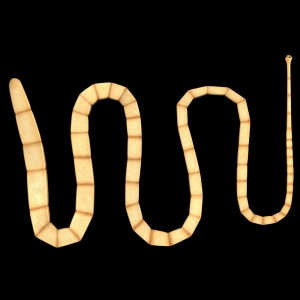Introduction
Taenia Solium or pork tapeworm comes in two forms of infestation in man.
First, if pork that is infested with cysticerci is eaten uncooked (pork tartare) or not well enough cooked, then the adult pork tapeworm develops attached to the human intestinal wall. This disease entity is almost indistinguishable from the beef tapeworm.
However, when the pork tapeworm has been growing for some time, some of the eggs from separated segments can get vomited up or regurgitated and then swallowed again. This will now release the larvae, which penetrate the gut, get into the blood stream and migrate throughout the internal organs and muscles of the body and can also invade the brain (see life cycle, thanks to www.humanillnesses.com for this image).
This condition is called “cysticercosis“. Most of the time pork tapeworm (the intestinal form) is spread by consuming uncooked pork. In endemic areas such as Latin America, India and South Africa it may be almost impossible to suppress all of the cysticercosis cases as eggs can get airborne in dust and thus can enter the body through inadvertent inhalation.
Signs and Symptoms
The adult pork tape worm in the intestine is usually asymptomatic, there may perhaps be some nausea and the occasional abdominal pain, but nothing too obvious to the patient. Cysticercosis on the other hand is a chronically deteriorating condition, where for 3 to 5 years hardly any symptoms occur.
The symptoms originate from dying cysticerci, as they release breakdown products that evoke a strong immunological and anti-inflammatory response. As antibodies attack these cysticerci, more of them die off and it is often when the disease is treated with medication that symptoms are flaring up. Muscle aches are common. If neurocysticercosis is present, the brain is affected with the disease and seizures can suddenly occur, obstruction of the cerebrospinal fluid with elevation of pressure, drowsiness, neurological deficits, meningitis and even progression into a coma.
Diagnostic tests
Often fecal samples can detect gravid segments, or free eggs. With neurocysticercosis an MRI scan or CT scan of the brain shows multiple cysticerci (= calcified cysts), which can be clearly seen as white spots in the otherwise grey appearing brain. There is also a very sensitive and specific immunoblot blood test that can be used to confirm the diagnosis.
Treatment
Treatment for T. solium for the intestinal form is similar to treating T. saginata. A single dose of praziquantel (brand name: Biltricide) is effective. Alternatively niclosamide can be given as a one dose treatment. Either of these drugs allows the patient to pass a dead tapeworm in 90% of all cases. For neurocysticercosis treatment consists of a 15 day course of praziquantel. In many development countries Albendazole is used instead, which is cheaper. The specialist must carefully follow the patient to ensure that the cysts are no longer containing viable T. solium. This may be difficult to achieve, if there are violent reactions with every treatment attempt. Corticosteroids may have to be used to soften the immune reactions. In some cases neurosurgery may have to be done to reopen plugged CSF passages or a shunt may have to be inserted.
References:
1. The Merck Manual, 7th edition, by M. H. Beers et al., Whitehouse Station, N.J., 1999. Chapter 161.
2. TC Dixon et al. N Engl J Med 1999 Sep 9;341(11):815-826.
3. F Charatan BMJ 2000 Oct 21;321(7267):980.
4. The Merck Manual, 7th edition, by M. H. Beers et al., Whitehouse Station, N.J., 1999. Chapter 43.
5. JR Zunt and CM Marra Neurol Clinics Vol.17, No.4,1999: 675-689.
6. The Merck Manual, 7th edition, by M. H. Beers et al., Whitehouse Station, N.J., 1999. Chapter 162.
7. LE Chapman : Antivir Ther 1999; 4(4): 211-19.
8. HW Cho: Vaccine 1999 Jun 4; 17(20-21): 2569-2575.
9. DO Freedman et al. Med Clinics N. Amer. Vol.83, No 4 (July 1999): 865-883.
10. SP Fisher-Hoch et al. J Virol 2000 Aug; 74(15): 6777-6783.
11. Mandell: Principles and Practice of Infectious Diseases, 5th ed., © 2000 Churchill Livingstone, Inc.
12. Goldman: Cecil Textbook of Medicine, 21st ed., Copyright © 2000 W. B. Saunders Company
13. PE Sax: Infect DisClinics of N America Vol.15, No 2 (June 2001): 433-455.
14. David Heymann, MD, Editor: Control of Communicable Diseases Manual, 18th Edition, 2004, American Public Health Association.







